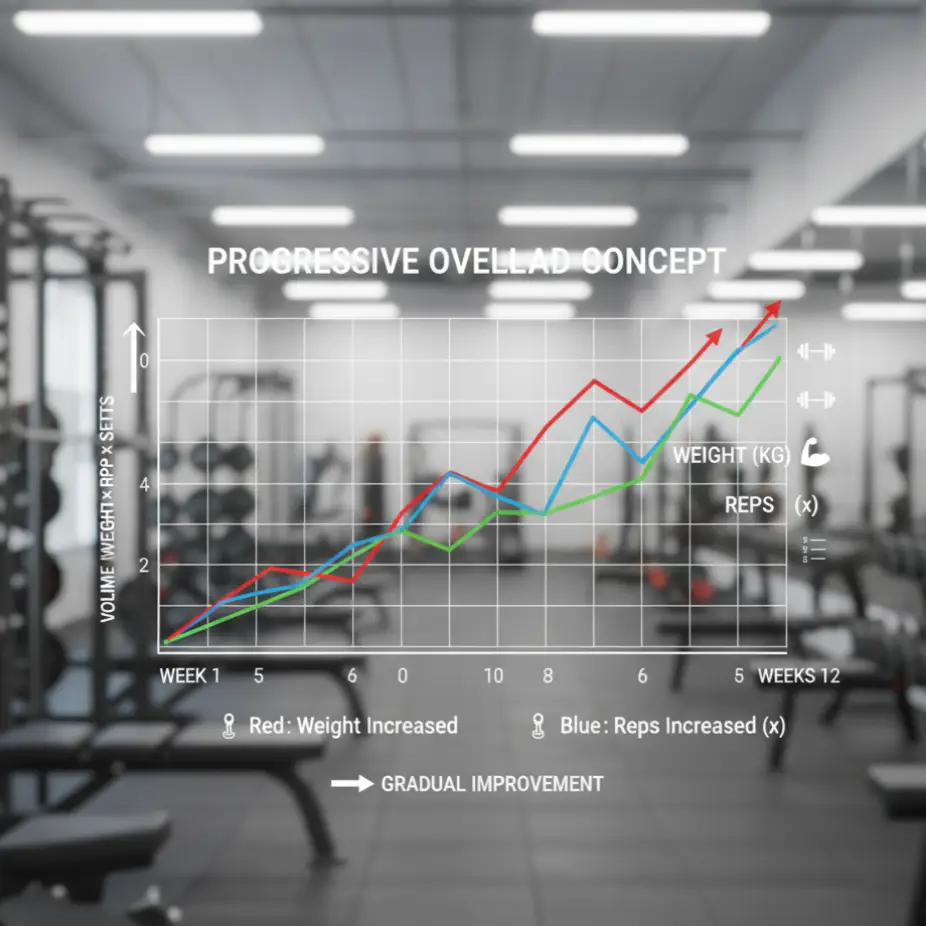Progressive overload for beginners is the foundation of strength training. If you want to build muscle, increase weights safely, and make steady beginner strength gains, you must apply lifting progression consistently. This guide gives you practical strength training tips backed by science and experience.

Table of Contents
Understanding Progressive Overload for Beginners
The Science of Beginner Strength Gains
When you first start training, your body adapts quickly. Neural efficiency improves, muscles activate more fibers, and strength increases even before visible muscle growth. This “newbie phase” is powerful, but it only lasts if you challenge your body with progressive overload. Without it, your beginner strength gains stall.
Why Lifting Progression Drives Long-Term Results
Strength training is about adaptation. Each time you lift slightly more, your muscles repair stronger. Progressive overload keeps that cycle going. Beginners who apply lifting progression see not only muscle growth but also improved bone density, metabolism, and joint stability.
How Progressive Overload Works in Strength Training
Volume, Intensity, and Frequency Explained
Progressive overload doesn’t mean adding weight every workout. Instead, it’s the balance of:
- Volume: total sets × reps × weight
- Intensity: how heavy the load feels relative to max
- Frequency: how often you train each muscle group
Adjusting these factors ensures safe and consistent lifting progression.
Balancing Recovery with Progression
Muscles grow when you rest, not when you train. Beginners often underestimate recovery. If you push volume or intensity too fast, you risk injury. Proper sleep, nutrition, and recovery days keep you progressing without setbacks. (See: Strength Training Recovery)
Progressive Overload Methods for Beginners
Adding More Weight Gradually
The simplest method is to increase weights safely by 2–5% once you complete all sets and reps with good form. For example, if you squat 100 lbs for 3×10, once that feels easy, move to 105 lbs. Small jumps prevent overloading joints and reduce injury risk.
Increasing Reps, Sets, or Training Density
If weights can’t increase, you can apply overload by:
- Adding 1–2 more reps per set
- Performing an extra set
- Reducing rest times for more work in less time
These strategies are especially helpful for bodyweight strength training. (See: Bodyweight Strength Training)
Progressive Overload Workout Plans
Example 4-Week Progression Workout Plan
Here’s a simple plan for beginners:
| Week | Progression Method |
|---|---|
| Week 1 | Baseline: Choose weights you can lift for 3×8 with effort |
| Week 2 | Add 1 rep per set (3×9) |
| Week 3 | Increase weight 2–5% and return to 3×8 |
| Week 4 | Repeat cycle with gradual increases |
For a full beginner plan, see: Beginner Strength Training Plan
12-Week Progressive Overload Program PDF Reference
Many beginners look for structured plans like a 12-week progressive overload program PDF. These programs outline exact rep and weight increases for squats, presses, and deadlifts. While templates help, always listen to your body and progress at your own pace.
Progressive Overload at Home vs. Gym
Bodyweight Progressive Overload Examples

You can build strength at home using bodyweight exercises. For push-ups:
- Start with 3×8 regular push-ups
- Progress to 3×12
- Move to decline push-ups or weighted backpack push-ups
This method keeps the principle of progressive overload alive without equipment.
Using Resistance Bands and Dumbbells at Home
If you train at home, resistance bands and dumbbells provide progression. Bands increase tension as they stretch, while dumbbells allow precise weight jumps. For guidance, see: Dumbbell Strength Training
Common Beginner Mistakes in Progressive Overload
Rushing Progression and Overtraining
Beginners often think lifting heavier faster means quicker results. Instead, rushing increases injury risk. Respect your body’s pace. Focus on gradual improvements. (See: Common Strength Training Mistakes)
Ignoring Form and Recovery Time
Adding weight without mastering form leads to breakdowns. Always prioritize form first. Combine that with recovery—missing sleep or training daily will stall progress.
PART 7: Progressive Overload Tracking Tools
Using a Progressive Overload Calculator
A progressive overload calculator helps beginners plan safe increases. You input your current max, and it suggests weekly weight jumps. This prevents guessing and keeps progression structured.
Tracking Workouts with Apps or Journals
Whether you log workouts in a notebook or an app, tracking is non-negotiable. Seeing numbers rise over weeks is motivating and ensures you apply overload consistently.
Long-Term Strength Training Success
When to Adjust Training Intensity
After several months, beginners need to modify plans. If lifts stall for more than 3 weeks, it’s time to change volume or intensity. This adjustment prevents plateaus and keeps strength training effective.
Importance of Nutrition, Sleep, and Recovery
Progressive overload is not only about lifting. Nutrition fuels muscle repair, sleep releases growth hormones, and recovery avoids burnout. For women especially, progression should respect recovery cycles. (See: Strength Training for Women Beginners).
Conclusion: Actionable Takeaways for Beginners
- Apply progressive overload gradually for safe results
- Track your lifting progression weekly
- Use multiple methods: more reps, sets, or weight
- Balance training with recovery and nutrition
- Stay consistent for lasting beginner strength gains
FAQs
Progressive overload for beginners PDF — where can I find one?
Many fitness coaches publish free PDFs. Strongil offers structured beginner strength plans that include progressive overload principles.
What is a progressive overload workout plan?
It’s a structured program where weights, reps, or sets gradually increase each week. See Full Body Strength Training for examples.
What’s the difference between progressive overload at home vs. gym?
At home, you apply overload with bodyweight, bands, or dumbbells. In the gym, you use barbells and machines for precise weight increases.
How do I know if I’m applying progressive overload correctly?
If your weights, reps, or sets improve over weeks, you’re progressing. Use a calculator or workout journal for accuracy.
Visit my Instagram account for more
